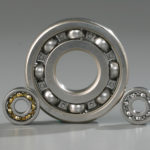Selecting the proper shaft and housing fit is critical in optimizing a radial ball bearing’s performance and life. A bearing can only perform to its full capacity when it is correctly fitted on the shaft and in the housing. Conversely, improper bearing fits, too loose or too tight, can lead to undesirable operating conditions and early failure.
Types of Loading for Radial Ball Bearings
Circumferential loading occurs in the case of a rotating ring and a stationary load, or with a stationary ring and a rotating load. Under these conditions, forces are acting to displace the ring relative to its seating surface and every point on the raceway is subjected to load during one revolution of the bearing.
Point loading occurs in the case of a stationary ring and a stationary load, or a rotating ring and a rotating load. In these cases, the ring remains stationary relative to the direction of the load. Under these conditions, there are no forces acting to displace the ring relative to its seating surface.

Types of Fits for Radial Ball Bearings
Loose (or clearance) – It is a fit that always enables a clearance between the hole and shaft in the coupling. The lower limit size of the hole is greater or at least equal to the upper limit size of the shaft
Transitional – It is a fit where (depending on the actual sizes of the hole and shaft) both clearance and interference may occur in the coupling. Tolerance zones of the hole and shaft partly or completely interfere.
Tight (or interference) – It is a fit always ensuring some interference between the hole and shaft in the coupling. The upper limit size of the hole is smaller or at least equal to the lower limit size of the shaft.
More Info
For rings that are subjected to circumferential loading select a tight fit. Insufficient interference on fitting surfaces could cause bearing rings to creep in a circumferential direction. Once this happens, considerable wear occurs on the fitting surface and both shaft and housing are damaged. Furthermore, abrasive particles may enter the bearing causing vibration, excessive heat and damage to raceways. It is therefore necessary to provide bearing rings under rotating load with an adequate interference fit to prevent creep.
For rings that are subjected to point loading a loose fit is permissible. Statically loaded bearings generally do not need to be fitted with an interference fit. Only when subject to a high degree of vibration do both inner and outer rings require fitting with an interference fit.
If you need help in selecting the best thrust ball bearing, thrust roller bearing, or small thrust bearing for your particular application, please remember that design engineering and application assistance are available from AST as part of our value-added services designed to make your job easier. Click here to contact us for more information.

